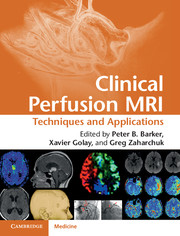Book contents
- Frontmatter
- Contents
- List of Contributors
- Foreword
- Preface
- List of Abbreviations
- Section 1 Techniques
- 1 Imaging of flow: basic principles
- 2 Dynamic susceptibility contrast MRI: acquisition and analysis techniques
- 3 Arterial spin labeling-MRI: acquisition and analysis techniques
- 4 DCE-MRI: acquisition and analysis techniques
- 5 Imaging of brain oxygenation
- 6 Vascular space occupancy (VASO) imaging of cerebral blood volume
- 7 MR perfusion imaging in neuroscience
- Section 2 Clinical applications
- Index
- References
7 - MR perfusion imaging in neuroscience
from Section 1 - Techniques
Published online by Cambridge University Press: 05 May 2013
- Frontmatter
- Contents
- List of Contributors
- Foreword
- Preface
- List of Abbreviations
- Section 1 Techniques
- 1 Imaging of flow: basic principles
- 2 Dynamic susceptibility contrast MRI: acquisition and analysis techniques
- 3 Arterial spin labeling-MRI: acquisition and analysis techniques
- 4 DCE-MRI: acquisition and analysis techniques
- 5 Imaging of brain oxygenation
- 6 Vascular space occupancy (VASO) imaging of cerebral blood volume
- 7 MR perfusion imaging in neuroscience
- Section 2 Clinical applications
- Index
- References
Summary
Introduction
It is well known that elevated neuronal activity is accompanied by increased glucose and oxygen delivery to tissue. As these substrates are delivered to the tissue by the blood, changes in cerebral blood flow (CBF), or perfusion, are also closely associated with modulations in neuronal activity. Thus, information regarding brain function can be obtained from measurements of CBF, and corresponding measurements of hemodynamic activity have emerged as the most popular approach for assessing changes in brain function [1–4]. CBF, defined in Chapters 1 and 3, is the rate at which the blood is delivered to tissue (generally reported in units of ml blood/100 g tissue/min), as opposed to the quantity or velocity of blood in vessels. It is known that functionally driven changes in hemodynamic activity are associated with complex cerebrovascular interactions between perivascular neurons, glio-vascular and intramural vascular signaling; however, the precise mechanisms by which neuronal activity elicits changes in CBF have not been fully established [5].
- Type
- Chapter
- Information
- Clinical Perfusion MRITechniques and Applications, pp. 103 - 126Publisher: Cambridge University PressPrint publication year: 2013
References
- 2
- Cited by

